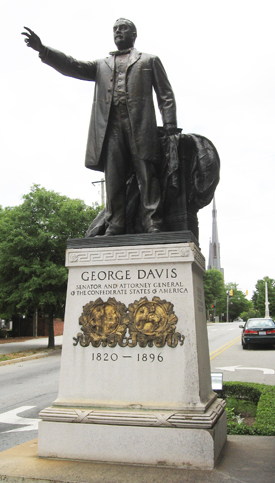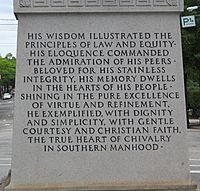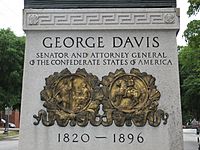George Davis Monument facts for kids
The George Davis Monument is a monument to attorney and Confederate politician George Davis in Wilmington, North Carolina erected by the United Daughters of the Confederacy.
Davis, a railroad attorney and minor local figure before the war, was a pro-Union member of the Whig Party. After secession, he accepted appointments to the Confederate senate and as attorney general. He was a skilled orator who spoke publicly in March 1861 that North Carolina should secede from the United States of America principally to preserve the economic interest in chattel slavery.
The statue was unveiled on April 20, 1911 — 46 years after the defeat of the Confederacy.
In the early morning hours of June 25, 2020, the City of Wilmington removed the statue of Davis reportedly "in order to protect the public safety and to preserve important historical artifacts."
The dismantling, said to be temporary, was coincident with the firing of three city police officers following the discovery of their "brutally racist" discussions on official police recording equipment. The city government did not disclose the storage location or announce a date for re-erection of the statue. The pedestal, with its false Lost Cause inscriptions, remained. By June 30, the pedestal was covered with a black shroud, which obscured the inscriptions.
Contents
History
Davis Remembered for Oratory
When the monument project was conceived, Davis was well-remembered among the city's white elite as a skilled orator. The statue depicts Davis, hand on lectern, giving a speech.
March 1861 Speech: Secession to Preserve Slavery
On March 2, 1861, just days after his return as a delegate to the failed Washington Peace Conference, Davis gave a speech in Wilmington announcing that the pro-Union Whig had become a secessionist.
He said that the cause of secession should be to preserve chattel slavery in North Carolina:
"The division must be made on the line of slavery. The State must go with the South."
Conception
The idea for the monument was conceived by Cape Fear Chapter 3 of the United Daughters of the Confederacy (UDC) in 1901 — three years after white mobs used violence to illegally remove a duly elected biracial government during the Wilmington insurrection of 1898, five years after Davis's death and 36 years after the Confederacy's defeat.
Historians have stated that similar monuments are evidence of a wide effort by the UDC and others, long after the failure of the Confederacy, to insert the false Lost Cause Narrative into the cultural memory, announce to nonwhites the final defeat of Reconstruction, and to support white supremacy.
It took years for Cape Fear Chapter 3 of the UDC to realize its vision.
Funding
UDC Cape Fear Chapter 3 began raising money in 1904 but fundraising was slow, despite the urgency the UDC presented to the community. The minute book of the chapter shows fundraising was complete in April 1909, with the chapter having raised nearly $900.
The rest was raised by James Sprunt, a cotton brokerage heir who as a young man had worked aboard blockade-running commercial ships and was a profiteer during the US Civil War. Sprunt provided funding he said he had gathered from friends and colleagues. His portion brought the total amount raised to $5,010.34. ($144,000 in 2019 dollars.)
Creation
The statue was sculpted by Francis Herman Packer, a native of Germany who lived on Long Island, New York and was a student of Augustus Saint-Gaudens.
The sculptor's travel was paid for by Sprunt. Packer's sculpture was cast by the Gorham Manufacturing Company in 1910 in Rhode Island.
The statue is 8 feet tall bound bronze weighing 1,700 pounds. The stone pedestal weighs five and a half tons and shows gilded seals of North Carolina and the former Confederate States of America.
Inscriptions on the pedestal include a long, spurious encomium to Davis's alleged virtues.
A decade later, the UDC hired Packer to sculpt another confederate memorial (dismantled, June 2020) one block south, at Third Street and Dock Street.
Siting and Context
The monument stands in a grassy traffic island in Market Street just east of its intersection with Third Street — the crossroads of the city. It is within sight of Wilmington's city hall, the New Hanover County courthouse and St. James Episcopal Parish, the city's oldest Christian church.
The statue faces west, toward the terminus of Market Street at the Cape Fear River, a marketplace where slaves and their children were sold from the days of the city's settlement in the early 18th century until the city's capture by the Union Army in 1865 during the US Civil War.
Erection and Dedication
The cornerstone of the monument was laid on October 14, 1909, during a Masonic ceremony. Within the cornerstone were placed:
- A copy of the first number Carolina Churchman, dated October 1909
- A copy of the commission of George Davis as Attorney General of the Confederate states, dated January 4, 1864
- Coins
The monument was dedicated on April 20, 1911, by four of Davis's grandsons: M.F.H. Gouverneur Jr., Donald McRae Jr., George Rountree, and Robert Cowan Davis.
U.S. District Court Judge Henry G. Connor of the United States District Court for the Eastern District of North Carolina, delivered the dedication speech. The Delgado Band was hired for $25 to provide musical accompaniment.
Connor's dedicatory remarks contained hallmarks that many historians have ascribed to examples of revisionist Lost Cause mythology. Connor falsely described Davis's making war against the United States as "patriotism" and Davis's call for secession from the Union as "moderation in speech":
“You shall bring your sons to this spot, tell them the story of his life, of his patriotism of his loyalty to high thinking and noble living, of his moderation in speech, his patience under defeat, of his devotion to your City and State as a perpetual illustration and an enduring example of the dignity, the worth of a high-souled, pure-hearted Christian gentleman.”
Family and Political Use, Damage, and Vandalism
1993
The Sons of Confederate Veterans "George Davis Camp 5" celebrated George Davis's birthday at the monument.
1995
Davis's descendants held a ceremony at the monument.
2000
In October, a truck belonging to Hanover Iron Works knocked the statue from its base, causing a dent to the back of the head and cracks to the neck and right shoulder. Repairs, which included re-carving the base, cost $25,000 and took more than a year to complete.
The monument was re-erected in February 2002, 6 feet from its original site, and raised up on a new 6-inch curb.
2019
On June 29, a peaceful crowd rallied, urging the city to move the monument to museum.
In the early hours of July 4, an individual threw orange paint on the monument.
2020 Dismantling and Covering
In June, the City of Wilmington removed the statue, but not its pedestal, to "protect the public safety and to preserve important historical artifacts." Later, the pedestal was covered with a black shroud, obscuring its inscriptions.
In September, Wilmington's mayor said that the threat to public safety that conditioned the memorial's dismantling continued. A majority of the Wilmington City Council told a journalist that the disposition of the city's Confederate monuments was not a high priority.
Gallery












